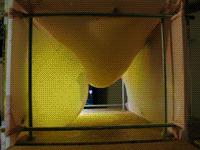Palaces are constructed to glorify empires, factories are built to optimize production, and public squares write important chapters of history. Yet the most quintessential purpose of architecture begins from the earliest evidence of the human attempt of organization of spaces for living. Archaeologist believed the gathering around the fire was the first conscious attempt to organized spaces for the everyday living. Even though these primeval spaces are open, indeterminate and ambiguous at the margins, the heat radiating from the fire defines the limits of space. Architecture is not restricted to the built structure. Human beings are hot-blooded animals, it is a matter of survival to maintain at a temperature that is necessary for enzymic activities. The formal evolution of the fire evolved into the hearth and then into heaters, air conditioners and the other climate control strategies as gradually architectural origin and the form lost connection.
This disconnection presents a problematic worldwide cultural phenomenon of anesthetized built environments, where architecture became an opaque package of technology, totally unresponsive to the thermal origin of architecture and the climate. This disconnection also led to the building sector’s over dependence on energy consumption to maintain comfort. Instead, if mankind revisits the making of fires, shelters and places of protection from the heat of the sun, then this connection can be repaired. Our thermal environment is as rich in cultural associations as our visual, acoustic, olfactory, and tactile environments. This thesis explores the potential for using thermal qualities as a performative and expressive element in architecture.
In the history, vernacular architecture demonstrates many thermal qualities that are expressive and performative. The modern term of “passive house” also exemplifies passive solar strategies for energy efficiency. A new term must arise from old concepts in order to encompass the whole segment of building forms. “Thermoceptive architecture” by definition is the architecture of condition, characterized by the compelling experience of hot and cold that turns the occupants’ senses more highly attuned and more perceptive inevitably establishing a strong “sense of place”. “Sense” of place may often be equated to comfort, or to a sense of existence in a particular space.
This is aided by the patterns of materials, light, dark, circulation of air, access to sunlight and shade and insulation from extremes. Yet our receptor for hot and cold is not one sense but a combination of all of our senses. Our visual, acoustic, olfactory and tactile senses combined add to our perception of the thermal quality. All of our senses are key to repair the broken connection between the thermal environment and us…
"The flow of energy through a system acts to organize that system." The sun should organize our system, but in many forms. Sun generate wind, generate food… we consume food and exert exergy.
Cultural factor
Therefore, the conclusion is to present the merits of incorporating thermoceptive design into a wider extent of the current built environment; new and existing.
Based on the hypothesis: if … then …
“The sense of temperature and temperature changes (Thermoception). The skin sensation of passing suddenly from a pocket of warm air to a pocket of cool. I don’t know that causes that, especially on dawn river trips, but I like it. And there’s a part of me that misses being barefoot in a Grumman and feeling the water temperature change through the soles of my feet when poking up some tributary.”
- A solotrip paddler


